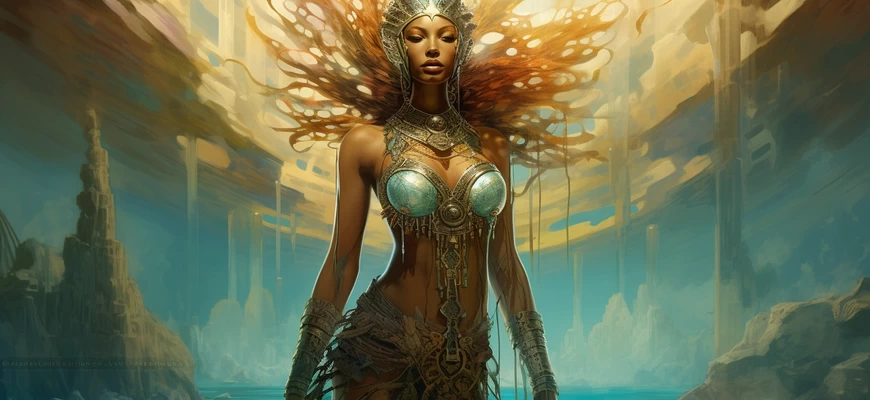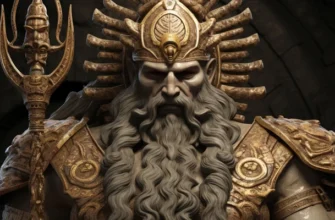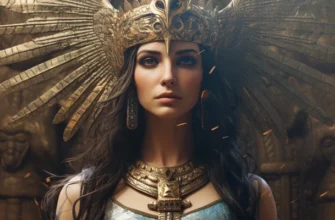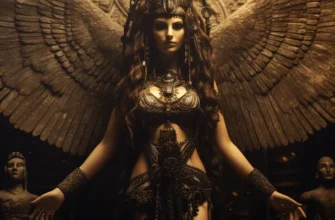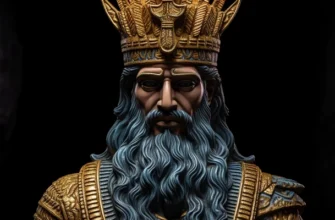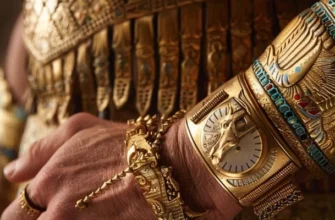The Sumerians, a great civilization of the ancient East, made history not only for their inventions but also for their multifaceted pantheon of gods. One of the key figures in this pantheon was the goddess Nammu.
Nammu was believed to have emerged from water and chaos, symbolizing her role in the creation of the world. Her genealogy was linked to other important gods.
Nammu was seen as a creator from pure potential. Her body and energy were considered the foundation for all living things, and her presence of water was a means of ensuring fertility.
The cult of Nammu was accompanied by complex religious rites and shrines. Prayers to the goddess were aimed at ensuring a good harvest and a happy life.
Nammu is not only a goddess, but also a symbol of life and creation that influenced the worldview of the ancient Sumerians.
- The importance of the goddess in the context of the religious pantheon
- Origin and genealogy of Nammu
- Legends about the creation of the goddess
- Relationship with other gods
- Role in the creation of the world
- The cult of Nammu
- Architectural features of religious buildings
- Symbolism and archaeological findings
- Influence on culture
- References to Nammu in Sumerian texts
- Depictions of the goddess in art
- Modern interest in Nammu
- The influence of Sumerian mythology on modern culture
- Conclusions
The importance of the goddess in the context of the religious pantheon
The goddess Nammu played an important role in the context of the Sumerian religious pantheon. Her significance encompassed several aspects:
Creative Element: Nammu was viewed as the creative element from which life arose. Her origin from water and chaos symbolized the beginning and flow of everything that exists.
Patroness of Fertility: The goddess was the patroness of fertility and harvest. The fertility of the land and the well-being of the people depended on her to ensure an abundance of food.
Elemental Powers: Her connection to water and the natural elements made her a symbol of the elemental forces that influenced human life and the natural world.
Creation and Rulership: Nammu played a key role in the creation of the world, and her dominion over water signified control over a vital element.
Religious Rites: Her cult was accompanied by a variety of religious rites and shrines where people would approach her with prayers and worship to receive blessings.
In summary, the goddess Nammu played a decisive role in shaping the Sumerian religious worldview, acting as a key figure that united elements of creation, nature, and religious worship.
Origin and genealogy of Nammu
The origin and genealogy of the goddess Nammu in Sumerian mythology are tied to the creation of the world and the deities who control natural forces. According to the myths:
Origin: Nammu emerged from chaos and water. Her origin symbolizes the beginning of life and the creative act that underlies everything that exists.
Genealogy:The goddess is related to other important deities of the Sumerian pantheon. She is often listed as the mother or family member of other gods.
Interaction with Other Gods: Nammu often collaborated or came into conflict with other deities. Her interactions with other members of the pantheon shaped not only her role in creation, but also in other aspects of mythology.
Power over the Elements: In some myths, Nammu possesses the elements, especially water, which in Sumerian culture was considered the force of creation and life.
The origin and genealogy of Nammu are important components of her mythology, in which she represents not only a divine aspect but also a key element of creation and the structure of the universe in Sumerian beliefs.
Legends about the creation of the goddess
The Sumerian creation legends of the goddess Nammu stem from a multilayered mythological narrative where she plays an important role in the creation of the world and the origin of life. The main aspects of the legends include:
Emergence from Water and Chaos: According to the myth, Nammu emerged from chaos and water, which represents the beginning of all things. This act of creation defines her as the original element of the universe.
Creative Act: Nammu is seen as the creative principle from which life comes. Her body and existence are considered the foundation for the further development of life and nature.
Relationship to Other Gods: Legends indicate a close connection between Nammu and other important deities of the Sumerian pantheon. She may appear as their origin or interaction with them in the context of the creation of the world.
The function of the Creator and Mother: The goddess acts as the creator and mother who gives life to everything that exists. Her role is defined as a higher power that influences the nature and destiny of people.
These legends form the image of Nammu as a deity who carries not only the power of creation, but also the responsibility for fertility and harmony in the Sumerian world.
Relationship with other gods
The goddess Nammu in Sumerian mythology has a close connection with other important deities of the pantheon. Her interaction with other gods is deeply woven into the fabric of myths and religious lore:
Anu and Kishar: Nammu is often referred to as the daughter of Anu (father-heaven) and Kishar (mother-earth), reflecting her important role as the result of the union of the heavenly and the earthly.
Enlil: The goddess acts as the mother of Enlil, the god of wind and storm, who is also one of the most important gods in the Sumerian pantheon. Her interaction with Enlil emphasizes her role in creation and her influence on nature.
Enki (Eya): Another important god associated with Nammu is Enki, the god of fresh water and wisdom. Legends suggest how Nammu may be related to his sphere of dominion.
Minor gods: In various myths, Nammu may also appear alongside other gods who represent different aspects of nature and life.
In general, Nammu’s association with other deities makes her a key figure in the Sumerian pantheon, uniting different spheres of dominion and symbolizing the unity of nature and the cosmic order.
Role in the creation of the world
In Sumerian mythology, the goddess Nammu played a key role in the creation of the world, acting as a creative element and an initial force. The main aspects of her role in the creation of the world include:
The beginning of Life: Nammu emerged from chaos and water, symbolizing the beginning of all life. Her body and existence were considered the foundation for the further development of life.
Creative Principle: The goddess acted as the creative principle from which all things arose. Her presence in mythology indicated the need for a creative act to shape the world.
Ruling over Water: Nammu must rule over water, which in Sumerian culture was considered an essential element of creation. The control over water demonstrates its importance in the process of world formation.
Relationship to Other Gods:The goddess is often associated with other important deities, such as Anu and Kishar, indicating a close connection between the heavenly and earthly order.
Influence on Nature and Fertility:Nammu was the patroness of fertility and nature. Her energy and power of water influenced natural phenomena and ensured the fertility of the earth.
All this made the goddess Nammu not only one of the personifications of nature, but also a key factor in the process of creation and development of the world in Sumerian mythology.
The cult of Nammu
The cult of Nammu in Sumerian civilization was significant and included religious rites, shrines, and special areas of worship. The main aspects of the Nammu cult include:
Religious Rites and Sacrifices:Sumerian priests organized a variety of religious rites dedicated to Nammu. Sacrifices and water rituals may be among these rituals aimed at gaining blessings and fertility.
Shrines and Temples:Places of worship for the goddess were shrines and temples where religious rites and worship took place. These structures may be decorated with Nammu and water symbolism.
Religious Festivals:Special holidays and festivals were dedicated to Nammu, during which worshippers expressed their veneration and appeal to the goddess. These events may include religious processions, rituals, and festive dinners.
Prayers and Liturgies:Believers invoked Nammu in their prayers and liturgies, asking for blessings, fertility, and protection from negative influences.
Art and Writing:Nammu’s images were embodied in Sumerian art and writing, where the goddess’ symbolism occupied an important place. Pictographs and images could be used to express worship and communication with the deity.
The cult of Nammu constituted an important element of the Sumerian religion, shaping the way of life and views on interaction with nature and world forces.
Architectural features of religious buildings
The architectural features of religious buildings in the Sumerian civilization, in particular temples and shrines, reflect unique aspects of their religious and cultural identity. Some of the main architectural features of places of worship in the Sumerian context include:
Ziggurats:The typical form of cult architecture in Sumer was the ziggurat, a large terraced temple structure. A ziggurat consisted of numerous terraces or platforms, with a tall central tower structure. They symbolized the union of heaven and earth and served as a place for religious rites and mediation.
Terraces and Staircases:Ziggurats often had several terraces that rose to the top. Stairs or steps leading upward were used to get around the structure and perform religious rites.
Large Ceilings and Reliefs:Temples often featured large ceilings and reliefs that adorned the walls and depicted religious events, images of deities, and symbolism. These expressive artistic elements were used to express cultic concepts.
Water Elements:Temples dedicated to the goddess Nammu may have had ponds or canals, as water is important to the symbolism of the goddess of creation and fertility.
Sacred Architectural Details:Religious buildings were decorated with specific sacred details, such as paintings, abstract sculptures, and religious symbols, which enhanced the religious atmosphere of the temple.
These architectural features created sacred places for ritual rites, honoring the gods and communicating with them, and reflected the deep religious beliefs and cosmic view of the world in Sumerian society.
Symbolism and archaeological findings
Although specific archaeological finds or symbolism associated with the cult of the goddess Nammu may be limited or lost over time, general trends and archaeological discoveries can provide some guidance.
Glyphs and Writing: TheSumerians used writing on deeply ancient tablets and papyri. If there were textual records or glyphs related to the goddess Nammu, they could reveal details about her cult and rituals.
Artistic Depictions:Art and sculptures from the Sumerian period may depict the goddess Nammu, her attributes, and her role in mythology. Depictions of the goddess can reveal details about cult practices.
Amulets and Symbols:Finds of amulets or objects with symbols related to Nammu may indicate the veneration of the goddess and the use of her images in religious contexts.
Ceramic Objects:Ceramics were often used for religious and ritual purposes. Depictions of the goddess on ceramic objects may indicate her worship.
Excavations of Temples:Archaeological excavations of temples and shrines can reveal religious structures, three-dimensional forms, and decorations associated with the cult of a goddess.
All of these sources can help archaeologists and historians understand not only specific religious practices, but also the symbolism and role of the goddess Nammu in Sumerian society. However, it should be noted that the information is not always complete or accurate due to the fact that many ancient materials may be lost or damaged over time.
Influence on culture
The goddess Nammu, as an important element of Sumerian mythology, influenced the culture of this ancient civilization in various ways:
Religion and Rituals: Thecult of Nammu determined the religious views and beliefs of the Sumerians. The rituals and ceremonies associated with the goddess influenced their practices of honoring deities and ritualistic actions in temples.
Art and Symbolism:Depictions of the goddess could be seen in Sumerian art, sculptures and reliefs. The symbolism of Nammu had a great influence on the visual language of Sumerian culture.
Writing and Literature:Myths and legends about Nammu could be reflected in Sumerian texts. Texts that tell about the creation of the world and the role of the goddess in this process influenced Sumerian literature.
Architecture and Temples:Buildings dedicated to the goddess, such as temples and shrines, served as central points for religious and cultural activities. Architectural designs reflected religious beliefs and cult practices.
The Role of Women and Family Structure:The patronage of the goddess Nammu may be related to the role of women in Sumerian society. As the goddess of creation and fertility, she was important to the feminine aspect of Sumerian culture and family structure.
Views on Nature and the World:Concepts associated with the goddess Nammu shaped the Sumerian perception of nature, water, and cosmic forces. This influenced their philosophy and worldview.
The goddess Nammu defined some of the key aspects of the spiritual, cultural, and social spheres in Sumerian society, and her cult contributed to the formation of the unique identity of this ancient civilization.
References to Nammu in Sumerian texts
References to the goddess Nammu are found in Sumerian texts that reveal her role in Sumerian mythology and religion. Several references to Nammu can be found in the following Sumerian texts:
“Enuma Elish” (“When on High”):This is a Sumerian creation myth that describes the conflict between the gods and points to the important role of the goddess Nammu. She is depicted as the mother of the gods, representing chaos and creative potential.
“Atimu and Kumbaba:This epic text describes a battle between the god Atimu and the villain Kumbaba. In some versions of the text, Nammu appears as one of the goddesses who joins the fight against Kumbaba.
Liturgical Hymns:Liturgical hymns and prayers are found in Sumerian literature that address various gods, including the name Nammu. These texts may highlight aspects of the cult and worship of the goddess.
Administrative Texts:Administrative texts may contain references to ritualistic practices and areas of worship associated with Nammu.
Legal Texts:Some legal texts may contain references to ritual duties and responsibilities associated with the cult of the goddess Nammu.
These texts reflect various aspects of the cult of the goddess Nammu, revealing her role in Sumerian mythology and religious beliefs.
Depictions of the goddess in art
The Sumerian artistic tradition has left behind numerous depictions of the goddess Nammu, which are mainly found on slabs, stelae, and sculptures. Here are some possible aspects of her depiction in Sumerian art:
Female Figure:The goddess Nammu was often depicted in a female form, emphasizing her feminine attributes and her role in creation and fertility.
Water Elements:Since Nammu was associated with water, her depiction may include water elements such as rivers, waves, or waterfalls.
Fertility Attributes:An image of the goddess may include fertility attributes such as ears of wheat, symbolizing her power over the earth and nature.
Sacred Symbols:Her image may be adorned with various sacred symbols that reflect her role in mythology and religious system.
Ritual Scenes:Some images may depict the goddess in ritual scenes indicating her importance in cult rites.
Sacred Pose:The goddess’s pose may be sacred in nature, indicating her divine status and power.
Through these images, it is possible to gain insight into how Sumerian art reproduced ideas and symbolism associated with the goddess Nammu, as well as how these images were used to honor and express religious concepts in Sumerian society.
Modern interest in Nammu
Although the Sumerian civilization and the goddess Nammu existed in ancient times, interest in them in the modern world manifests itself in several ways:
Historical and Archaeological Research:Modern archaeological research continues to uncover and interpret artifacts and textual sources related to the Sumerian civilization and the goddess Nammu. This helps modern scholars understand more about this ancient culture.
Interest in Ancient Religions and Mythology:The general interest in ancient religions and mythologies contributes to the study of the goddess Nammu as part of the Sumerian pantheon. People are interested in the religious views and beliefs of ancient civilizations.
Art and Cultural Creativity:The goddess Nammu can be an object of creativity for contemporary artists, writers, and creators who find inspiration in ancient mythology to create new works of art.
Exploring the Feminine Aspect of Deities:Contemporary studies of feminist and gender history may emphasize the role of the goddess Nammu as a representative of femininity and fertility, as well as her influence on cultural ideas about women in ancient times.
Popularity among Ancient Civilization Enthusiasts:Ancient civilization and mythologyenthusiastsmay be interested in the goddess Nammu because of her role in Sumerian history and religion.
Modern interest in Nammu is driven by a research and cultural approach, expanding our understanding of the past and ancient beliefs.
The influence of Sumerian mythology on modern culture
The influence of Sumerian mythology on modern culture is complex and multifaceted. These ancient myths and legends have influenced various aspects of the modern world.
The rich myths of Sumerian mythology can serve as a source of inspiration for modern writers, artists, and filmmakers. Elements of Sumerian legends can be reflected in modern works of literature and art.
Certain concepts and aspects of the Sumerian religion may influence the religious thoughts and views of modern people, especially those interested in the study of ancient beliefs.
Elements of Sumerian mythology can be found in modern films, television programs, video games, and other forms of entertainment. Images of gods, mythical creatures, and events can appear in popular cultural products.
Concepts about the creation of the world, the struggle between good and evil, the role of man in the cosmos, and other philosophical aspects of Sumerian mythology may be of interest to philosophers and researchers.
The Sumerian civilization contributed to the development of writing and scientific achievements. The study of these aspects can influence modern curricula and research.
Although Sumerian mythology is lost in the depths of time, its influence lives on in the modern world through various cultural and scientific manifestations.
Conclusions
The goddess Nammu in Sumerian mythology is a significant element of the history and culture of this ancient civilization. Her role as the mother of the gods, the goddess of creation, and the ruler of water gives her a key place in the pantheon. As a symbol of fertility and creative energy, Nammu influenced the religious beliefs, rituals, and cultural expressions of the Sumerians.
Depictions of the goddess in art and texts reveal her feminine aspect, associated with fertility and water, which was of great importance to the Sumerian agricultural way of life. Her participation in the creation of the world, in the myth of Enuma Elish, emphasizes her importance in the creative order of the universe.
The legacy of the goddess Nammu is manifested in the modern interest in ancient civilizations, in science, literature, and art. Her influence is carried through the centuries, providing us with an understanding not only of religious beliefs but also of the cultural and philosophical aspects of the Sumerian heritage.
All of this suggests that the goddess Nammu not only reflects ancient history, but also remains an important figure that continues to inspire research and sensitivity to the cultural experience of the Sumerian people.
